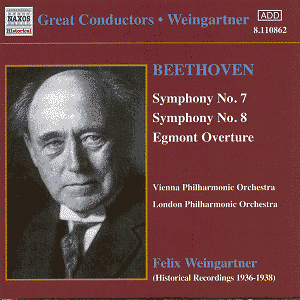No luxuriating in full orchestral sonority in the opening
forte chords of this 7th, just a quick sweep of the bow and on
with the job. Thus the stage is set for a purposeful, onward-moving
reading of the introduction.
So many performances of this symphony come to grief over the
rhythms in the first movement. If the first dotted 8th-note of
the pervasive dotted rhythm is allowed to get too short, the 3rd
and 6th 8th-notes of the bar are anticipated to sound like the
2nd and 4th 8th-notes of a bar of 2/4, the 6/8 spring is lost
and the movement just slogs. Tempo is crucial; beyond a certain
speed it is practically impossible to enunciate this rhythm correctly.
Very few performances avoid this trap entirely, the development
section being particularly vulnerable. Weingartner spells out
the rhythm on its first appearance with almost fanatical insistence;
thereafter there is exactly the right spring so that what seems
at first a steady pace builds up inexorably.
The second movement is notable for the clarity with which the
various melodies and counter-melodies are presented. Weingartner
does not drive the music but lets it unfold naturally, as though
presiding over a chamber music group rather then an orchestra.
Swift, joyful scherzos are another Weingartner feature and this
one is no exception, with a gently carolled trio which is not
allowed to sag. The finale sets off at a tempo which lets us hear
all the notes, depending on inner vitality rather than furious
driving. Occasionally the movement runs ahead of the tempo but
the spontaneity is irresistible. In its day this performance had
to compete with the famous Toscanini New York version which many
critics still consider to be the greatest performance of this
symphony on record. Those who set store by humanity, depth of
feeling and tradition in the best sense of the word will feel
that Weingartner is not to be set aside lightly.
The performance of the 8th Symphony is surely exceptional by
any standard. There is no question of this being a minor interlude
between the serious matters of nos. 7 and 9; the first movement
immediately impresses by its full-bloodedness, weighty but not
heavy, forward-moving but not over-driven. The "metronome"
movement is brisk and insistent rather than delicate. Weingartner
seems to suggest that, rather than making a joke of Maelzel's
invention, Beethoven is telling us that it got on his nerves;
thus the occasional bursts of real rage come to have a meaning.
After so many swift and bracing scherzos, Weingartner gives full
dignity and breadth to the one real minuet in all of the nine
symphonies. Quite exceptionally delicious are the horn and clarinet
exchanges in the trio, and when the strings take over with their
creamy Viennese sound you feel that the music was born to be played
by this orchestra. The finale is kept relatively steady, its main
theme entering furtively as though looking around to see if the
coast is clear before giving way to a great burst of joy. Weingartner's
subtle pacing of this movement, gathering hymn-like expressiveness,
exuberance and a certain mystery into one single sweep reveals
a truly great musician at work.
Throughout these performances the Vienna wind are not always
infallible in their intonation but the strings are magnificent
in the clarity of their articulation and the precision with which
they place their accents. They are so again in the Egmont Overture,
which does not hang fire as I felt the recently-reissued Klemperer
version did; the listener is carried along by a powerful surge
of feeling. The two items recorded in London show that Weingartner's
essentially lean and transparent orchestral textures were a constant
feature of his work, no matter which orchestra he had before him.
Mark Obert-Thorn obtains sound from these recordings which is
as good as one dare hope for considering their age. I have an
idea that, the next time I listen to one of these symphonies purely
for pleasure, these are the versions I will play. This first Beethoven
cycle on disc still takes a lot of beating.
Christopher Howell
